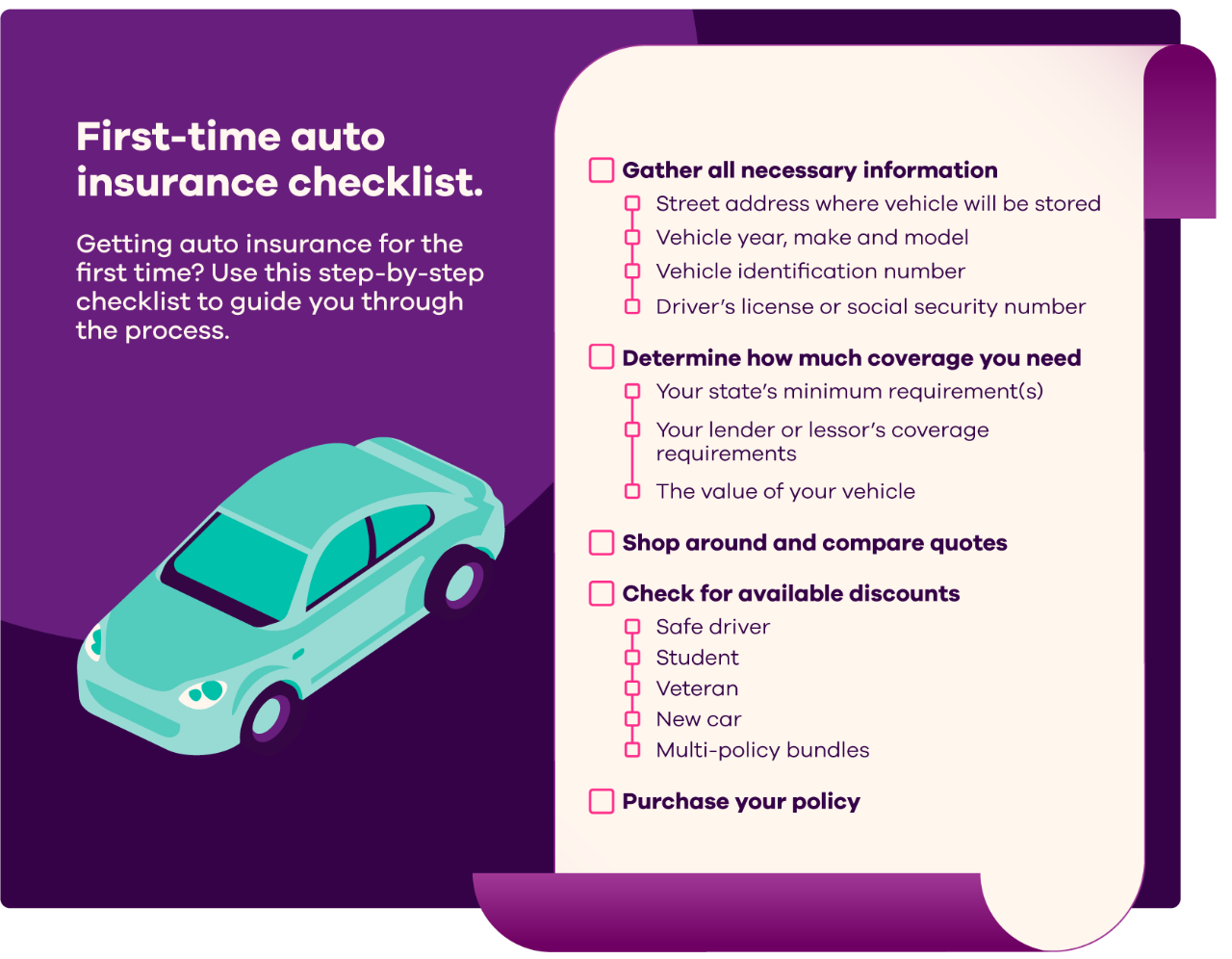Auto insurance tips for first-time car owners: A Comprehensive Guide
Embarking on the journey of owning your first car comes with the responsibility of understanding auto insurance. In this guide, we will delve into essential tips tailored for first-time car owners to navigate the world of auto insurance effectively.
Understanding Auto Insurance

Auto insurance is a contract between you and the insurance company that protects you against financial loss in case of an accident or theft involving your vehicle. It is a legal requirement in most states to have auto insurance when you own a car.
Types of Coverage for First-Time Car Owners
- Liability Coverage: This type of coverage helps pay for the other driver’s medical expenses and property damage if you are at fault in an accident.
- Collision Coverage: This coverage helps pay for repairs to your own vehicle in case of a collision with another vehicle or object.
- Comprehensive Coverage: This coverage helps pay for damages to your vehicle that are not caused by a collision, such as theft, vandalism, or natural disasters.
- Personal Injury Protection (PIP): This coverage helps pay for medical expenses for you and your passengers regardless of who is at fault in an accident.
- Uninsured/Underinsured Motorist Coverage: This coverage protects you if you are involved in an accident with a driver who does not have insurance or enough insurance to cover your damages.
Driving without auto insurance can lead to serious consequences, including fines, license suspension, vehicle impoundment, and even legal action. It is important to have the right coverage to protect yourself and others on the road.
Factors Influencing Auto Insurance Rates
Age, location, driving record, and type of car are key factors that can significantly impact auto insurance rates for first-time car owners. Insurance companies consider these factors when determining the cost of coverage, so it’s important to understand how each one can affect your premiums.
Age
Younger drivers, especially those under the age of 25, typically face higher insurance rates due to their lack of driving experience and higher likelihood of being involved in accidents. As drivers age and gain more experience, insurance rates tend to decrease.
Location
The location where you live can also impact your insurance rates. Urban areas with higher rates of accidents, theft, and vandalism may result in higher premiums compared to rural areas with lower incidences of these risks.
Driving Record
A clean driving record with no accidents or traffic violations can help lower insurance premiums, as it demonstrates to insurance companies that you are a safe and responsible driver. On the other hand, a history of accidents or traffic infractions may lead to higher rates.
Type of Car
The make and model of your car can influence insurance rates as well. Cars with high safety ratings and lower repair costs typically have lower insurance premiums. On the other hand, luxury vehicles, sports cars, and high-performance cars may come with higher insurance costs due to increased risk and repair expenses.
Comparing Insurance Companies
When shopping for auto insurance as a first-time car owner, it’s important to compare quotes from multiple insurance companies to find the best rates. Each insurer has its own pricing structure and factors they consider when calculating premiums, so exploring different options can help you secure affordable coverage.
Ways to Lower Premiums
There are several strategies that first-time car owners can use to potentially lower their insurance premiums. These include bundling auto insurance with other policies, maintaining a good credit score, taking defensive driving courses, and opting for a higher deductible. Additionally, driving safely and avoiding accidents can help keep insurance costs down over time.
Choosing the Right Coverage

When it comes to auto insurance, choosing the right coverage is crucial to ensure you are adequately protected in case of an accident or other unforeseen events. Understanding the differences between liability, collision, and comprehensive coverage is essential in making an informed decision.
Liability Coverage
Liability coverage is the most basic type of auto insurance and is required in most states. This coverage helps pay for injuries and property damage that you are legally responsible for in an accident. It does not cover your own injuries or vehicle damage.
- Make sure you have enough liability coverage to protect your assets in case of a lawsuit.
- Consider purchasing more than the minimum required by your state for added protection.
- Understand the different types of liability coverage, including bodily injury and property damage.
Collision Coverage
Collision coverage helps pay for repairs to your own vehicle after an accident, regardless of who is at fault. This coverage is especially important if you have a newer car that would be costly to repair or replace.
- Consider the age and value of your vehicle when deciding if collision coverage is necessary.
- Keep in mind that collision coverage comes with a deductible, which is the amount you have to pay out of pocket before your insurance kicks in.
- Choose a deductible that you can afford in case of an accident.
Comprehensive Coverage
Comprehensive coverage helps pay for damage to your vehicle caused by events other than a collision, such as theft, vandalism, or natural disasters. This coverage provides added protection beyond basic liability and collision coverage.
- Consider where you live and the likelihood of certain events, such as theft or severe weather, when deciding if comprehensive coverage is necessary.
- Like collision coverage, comprehensive coverage also comes with a deductible that you will need to pay before your insurance covers the rest.
- Review your policy limits and deductibles regularly to ensure they still align with your needs and budget.
Tips for Saving on Auto Insurance
When it comes to auto insurance, there are ways to save money without compromising on coverage. By taking advantage of discounts, bundling policies, and maintaining a good credit score, you can potentially lower your insurance costs.
Qualifying for Discounts
- Many insurance companies offer discounts for safe driving habits, such as maintaining a clean driving record without accidents or traffic violations.
- Completing a defensive driving course can also make you eligible for discounts with some insurers.
- Students with good grades or young drivers who have completed driver’s education courses may qualify for discounts.
Bundling Insurance Policies
- Consider bundling your auto insurance with other policies, such as homeowners or renters insurance, with the same company. This can lead to significant cost savings.
- Insurance companies often provide discounts for customers who have multiple policies with them.
Benefits of Maintaining a Good Credit Score
- Having a good credit score can positively impact your auto insurance rates. Insurers may view individuals with higher credit scores as less risky to insure.
- Improving your credit score by paying bills on time and reducing debt can help you secure lower insurance premiums.
- Some states prohibit insurers from using credit scores to determine rates, so be sure to check the regulations in your area.
Understanding Claims Process

When it comes to auto insurance, understanding the claims process is crucial for first-time car owners. Knowing how to file a claim, what information is needed, and how to handle claims efficiently can make a significant difference in the outcome of your insurance coverage.
Steps in Filing an Auto Insurance Claim
- Contact your insurance company as soon as possible after the accident to report the incident.
- Provide all necessary information such as your policy number, details of the accident, and any injuries sustained.
- Cooperate with the insurance adjuster assigned to your claim and provide any additional documentation or evidence as requested.
- Get an estimate for the repairs from a trusted auto repair shop approved by your insurance company.
- Review the settlement offer provided by the insurance company and negotiate if necessary to ensure fair compensation.
Information Needed When Reporting an Accident
- Date, time, and location of the accident
- Names and contact information of all parties involved
- Description of how the accident occurred
- Pictures of the damage to vehicles and any injuries sustained
- Police report number, if applicable
Tips for Handling Claims Efficiently
- Report the accident to your insurance company promptly to avoid any delays in processing your claim.
- Keep detailed records of all communication with the insurance company, including phone calls, emails, and letters.
- Follow up regularly on the status of your claim to ensure timely resolution.
- Seek legal advice if you encounter any difficulties in the claims process or if you believe you are not being treated fairly by the insurance company.
Outcome Summary
Concluding our discussion on auto insurance tips for first-time car owners, it’s crucial to grasp the intricacies of coverage options, factors influencing rates, and the claims process. With these insights, you can make informed decisions to protect your new wheels with confidence.
Questions and Answers
What are the different types of coverage available for first-time car owners?
First-time car owners can typically choose from liability, collision, and comprehensive coverage options.
How can new car owners potentially lower their insurance premiums?
New car owners can explore options such as qualifying for discounts, bundling insurance policies, and maintaining a good credit score to lower insurance premiums.




